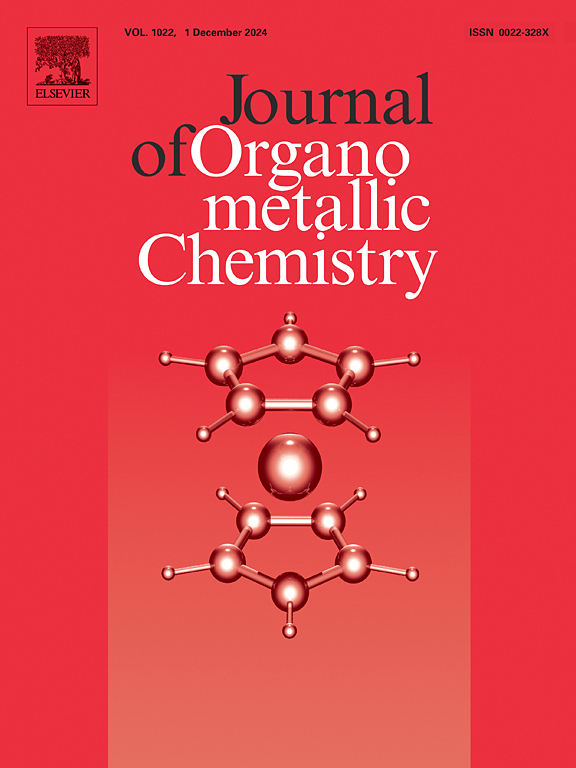Sodium lignosulfonate capped silver nanoparticles: Synthesis, characterization and its catalytic application in the CN coupling reactions and study of its anti-gastric cancer effects
IF 2.1
3区 化学
Q3 CHEMISTRY, INORGANIC & NUCLEAR
引用次数: 0
Abstract
In this study, a bio-inspired technique is used to synthesize and characterize an Ag NPs garlanded sodium lignosulphate (Ag NPs@NaLS) without the use of any hazardous or poisonous stabilizing or reducing chemicals. The morphological and structural characteristics were evaluated using a variety of physicochemical techniques, including elemental mapping, FT-IR, SEM, TEM, EDX, XRD, and ICP-OES. Under mild circumstances, the nanocomposite was catalytically investigated in the effective N-arylation of indole via Buchwald-Hartwig C![]() N coupling with various haloarenes. A relatively short reaction time was required to get an excellent yield. With minimal loss of catalytic activity, the nanocatalyst was readily recovered by centrifugation and recycled seven times. The cytotoxicity of the Ag NPs@NaLS bionanomaterial against stomach tumors was investigated further from a biological perspective. Following the MTT approach, the experiments were conducted against the typical gastric cancer cell lines AGS, and they showed notable in vitro actions to prevent their proliferation.
N coupling with various haloarenes. A relatively short reaction time was required to get an excellent yield. With minimal loss of catalytic activity, the nanocatalyst was readily recovered by centrifugation and recycled seven times. The cytotoxicity of the Ag NPs@NaLS bionanomaterial against stomach tumors was investigated further from a biological perspective. Following the MTT approach, the experiments were conducted against the typical gastric cancer cell lines AGS, and they showed notable in vitro actions to prevent their proliferation.

木质素磺酸钠包覆纳米银:合成、表征及其在CN偶联反应中的催化应用及抗胃癌作用研究
在这项研究中,一种生物启发技术被用于合成和表征银NPs花环木质素硫酸钠(Ag NPs@NaLS),而不使用任何危险或有毒的稳定或还原化学物质。使用多种物理化学技术,包括元素映射、FT-IR、SEM、TEM、EDX、XRD和ICP-OES,对其形态和结构特征进行了评估。在温和的条件下,研究了纳米复合材料通过Buchwald-Hartwig CN与各种卤代芳烃的有效n -芳基化反应。反应时间较短,收率高。催化活性损失最小,纳米催化剂很容易通过离心和循环七次回收。从生物学角度进一步研究了Ag NPs@NaLS生物纳米材料对胃肿瘤的细胞毒性。采用MTT方法,对典型胃癌细胞系AGS进行了体外抑制增殖的实验。
本文章由计算机程序翻译,如有差异,请以英文原文为准。
求助全文
约1分钟内获得全文
求助全文
来源期刊

Journal of Organometallic Chemistry
化学-无机化学与核化学
CiteScore
4.40
自引率
8.70%
发文量
221
审稿时长
36 days
期刊介绍:
The Journal of Organometallic Chemistry targets original papers dealing with theoretical aspects, structural chemistry, synthesis, physical and chemical properties (including reaction mechanisms), and practical applications of organometallic compounds.
Organometallic compounds are defined as compounds that contain metal - carbon bonds. The term metal includes all alkali and alkaline earth metals, all transition metals and the lanthanides and actinides in the Periodic Table. Metalloids including the elements in Group 13 and the heavier members of the Groups 14 - 16 are also included. The term chemistry includes syntheses, characterizations and reaction chemistry of all such compounds. Research reports based on use of organometallic complexes in bioorganometallic chemistry, medicine, material sciences, homogeneous catalysis and energy conversion are also welcome.
The scope of the journal has been enlarged to encompass important research on organometallic complexes in bioorganometallic chemistry and material sciences, and of heavier main group elements in organometallic chemistry. The journal also publishes review articles, short communications and notes.
 求助内容:
求助内容: 应助结果提醒方式:
应助结果提醒方式:


